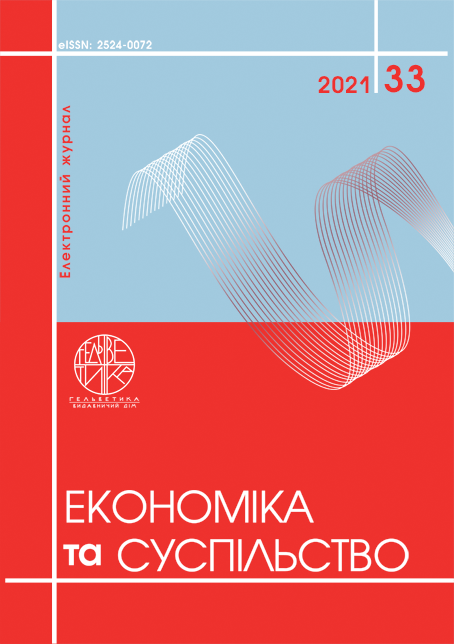FEATURES OF STRATEGIC PERSONNEL PLANNING IN THE CONDITIONS OF DIGITALIZATION
Abstract
Modern business causes changes in all areas of the organization, including in the field of strategic personnel planning. Strategic human resource planning is an important part of business, as human resources are key drivers for the development of any organization. The article shows the impact of the 4th Industrial Revolution on strategic personnel planning. In this regard, the stages of strategic personnel planning are shown. 4 phases of strategic human resource planning are identified and described: identification of critical areas of human resource planning, identification of excess or insufficient human resources, development of human resource planning strategy and implementation of personnel plans. The influence of information technologies on strategic planning of human resources is given. It was found that successful strategic human resource planning requires the implementation of the chosen strategy to achieve the goals of the organization, which are supported by human resource planning strategies. The action of the chosen strategy is based on the chosen plan and communication in the organization. How quickly the strategy of the organization will be achieved depends on the properly prepared strategy and its successful implementation in the personnel plans. Expanded use of information technology and databases, analysis of large amounts of data and the use of elements of decision support systems is a great advantage that helps to develop strategy and track goals. The use of intelligent decision support systems and artificial intelligence algorithms, as well as large data analysis and monitoring of the business environment are the challenges of the future that all organizations will face in the field of strategic human resource planning. Therefore, it is important that human resources activities are included in the formulation of business strategy, because in this case the process of strategic human resource planning can begin immediately. As part of the organization's management, the personnel manager in this case must be well acquainted with the work of individual departments and be not only an expert in the field of personnel planning, but also have management skills.
References
Грішнова О.А., Жорова Є.Р. Кадрове забезпечення ефективної системи антикризового корпоративного управління. Проблеми економіки. 2014. № 1. С. 193–198.
Жуковська В.М. Цифрові виклики кадрового забезпечення підприємства. Менеджмент та підприємництво в Україні: етапи становлення та проблеми розвитку. 2019. № 2. С. 10–17.
Шехлович А.М. Дослідження та удосконалення кадрового забезпечення інноваційної діяльності підприємств в умовах впровадження ІТ-технологій. Сайт 18.12. 2019. URL: http://iierlviv.files.wordpress.com/2019
Akgunduz, Y., Sanli, S. (2017). The effect of emloyee advocacy and perceived organizational support on job embeddeeness and turnover intention in hotels. Journal of Hospitality and Tourism Management, 31, 118–125.
Bagheri, J.(2016). Overlaps between human resource’ startegic planning and strategic management tools in public organizations. Social and Behavioral Sciences, 230, 430–438.
Bauer, W., Moritz, H., Stefan, G., Tobias, S. (2014). Planning flexible human resource capacity in volatile markets. IFAC Proceedings Volumes, 47(3), 4459–4464.
Bernik, I., Florjanсіс, J., Bernik, M.(2014). Strategic management and information system. Informatics and Management-selected topics, 13–27.
Bos, J.T., Donders, N.C.G.M., Velden, K., Gulden, J.W.J. (2013). BMC Research Notes, 6, 1–12.
Hrishnova, O.A., Zhorova, Ye.R. (2014). Kadrove zabezpechennia efektyvnoi systemy antykryzovoho korporatyvnoho upravlinnia [ Staffing of an effective system of anti-crisis corporate governance]. Problemy ekonomiky – Problems of the economy, 1, 193–198. (in Ukrainian)
Zhukovska, V.M. (2019). Tsyfrovi vyklyky kadrovoho zabezpechennia pidpryiemstva [Digital challenges of enterprise staffing]. Menedzhment ta pidpryiemnytstvo v Ukraini: etapy stanovlennia ta problemy rozvytku – Management and entrepreneurship in Ukraine: stages of formation and problems of development, 2, 10–17. (in Ukrainian)
Shekhlovych, A.M. (2014). Doslidzhennia ta udoskonalennia kadrovoho zabezpechennia innovatsiinoi diialnosti pidpryiemstv v umovakh vprovadzhennia IT-tekhnolohii [Research and improvement of staffing of innovative activities of enterprises in the implementation of IT technologies]. Retrived from: http://iierlviv.files.wordpress.com/2014. (in Ukrainian)
Akgunduz, Y., Sanli, S. (2017). The effect of emloyee advocacy and perceived organizational support on job embeddeeness and turnover intention in hotels. Journal of Hospitality and Tourism Management, 31, 118–125.
Bagheri, J. (2016). Overlaps between human resource’ startegic planning and strategic management tools in public organizations. Procedia – Social and Behavioral Sciences, 230, 430–438.
Bauer, W., Moritz, H., Stefan, G., Tobias, S. (2014). Planning flexible human resource capacity in volatile markets. IFAC Proceedings Volumes, 47(3), 4459–4464.
Bernik, I., Florjanсіс, J., Bernik, M.(2014). Strategic management and information system. Informatics and Management-selected topics, 13–17.
Bos, J.T., Donders, N.C.G.M., Velden, K., Gulden, J.W.J. (2013). BMC. Research Notes, 6.


